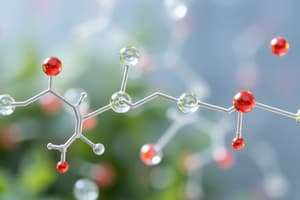Podcast
Questions and Answers
Amino acids exist as ______ even in the solid state due to the internal transfer of a hydrogen ion.
Amino acids exist as ______ even in the solid state due to the internal transfer of a hydrogen ion.
zwitterions
When an alkali is added to an amino acid solution, it removes a hydrogen ion from the ______ group.
When an alkali is added to an amino acid solution, it removes a hydrogen ion from the ______ group.
-NH3+
In electrophoresis, if an amino acid moves toward the anode, it indicates that the amino acid exists as a ______ ion.
In electrophoresis, if an amino acid moves toward the anode, it indicates that the amino acid exists as a ______ ion.
negative
Adding an acid to an amino acid solution causes the ______ part of the zwitterion to pick up a hydrogen ion.
Adding an acid to an amino acid solution causes the ______ part of the zwitterion to pick up a hydrogen ion.
During electrophoresis under acidic conditions, amino acids move towards the ______ because they become positively charged.
During electrophoresis under acidic conditions, amino acids move towards the ______ because they become positively charged.
When alkali is slowly added to an amino acid under acidic conditions, the hydrogen from the ______ group is removed first because it’s more acidic.
When alkali is slowly added to an amino acid under acidic conditions, the hydrogen from the ______ group is removed first because it’s more acidic.
The ______ is the pH at which an amino acid does not move towards either the cathode or anode during electrophoresis.
The ______ is the pH at which an amino acid does not move towards either the cathode or anode during electrophoresis.
The position of a colourless amino acid solution after electrophoresis can be found by spraying it with a solution of ______.
The position of a colourless amino acid solution after electrophoresis can be found by spraying it with a solution of ______.
The process of reversing the addition of hydroxide ions to an amino acid involves adding an ______ to the resulting ion.
The process of reversing the addition of hydroxide ions to an amino acid involves adding an ______ to the resulting ion.
In an amino acid, the ______ group is the stronger base and picks up hydrogen ions first when acid is added.
In an amino acid, the ______ group is the stronger base and picks up hydrogen ions first when acid is added.
The equilibrium positions of the reactions of zwitterions with water vary depending on the influence of the ______ group.
The equilibrium positions of the reactions of zwitterions with water vary depending on the influence of the ______ group.
When an amino acid solution is subjected to electrophoresis and drifts towards the positive electrode, it indicates a higher concentration of ______ ions.
When an amino acid solution is subjected to electrophoresis and drifts towards the positive electrode, it indicates a higher concentration of ______ ions.
To prevent an amino acid solution from drifting during electrophoresis, a small amount of ______ is added to reduce the concentration of negative ions.
To prevent an amino acid solution from drifting during electrophoresis, a small amount of ______ is added to reduce the concentration of negative ions.
The pH at which an amino acid does not migrate in an electric field is known as the ______ point.
The pH at which an amino acid does not migrate in an electric field is known as the ______ point.
At the isoelectric point, the concentrations of the positive and ______ ions of an amino acid are equal.
At the isoelectric point, the concentrations of the positive and ______ ions of an amino acid are equal.
The isoelectric point of an amino acid is not at pH 7 because the ______ interacts with water molecules, acting as both an acid and a base.
The isoelectric point of an amino acid is not at pH 7 because the ______ interacts with water molecules, acting as both an acid and a base.
Flashcards
Zwitterion
Zwitterion
An ion with both positive and negative electrical charges, but the overall charge is neutral.
Isoelectric Point
Isoelectric Point
The pH at which an amino acid exists as a zwitterion with no net electrical charge.
Amino Acid as Acid
Amino Acid as Acid
The -NH3+ group on an amino acid donates a hydrogen ion to water, acting as an acid.
Amino Acid as Base
Amino Acid as Base
Signup and view all the flashcards
Ion Imbalance
Ion Imbalance
Signup and view all the flashcards
Electrophoresis
Electrophoresis
Signup and view all the flashcards
Adding Acid
Adding Acid
Signup and view all the flashcards
Isoelectric Point Examples
Isoelectric Point Examples
Signup and view all the flashcards
What is a zwitterion?
What is a zwitterion?
Signup and view all the flashcards
How do amino acids exist in solution?
How do amino acids exist in solution?
Signup and view all the flashcards
What happens when alkali is added?
What happens when alkali is added?
Signup and view all the flashcards
What is electrophoresis?
What is electrophoresis?
Signup and view all the flashcards
What happens when acid is added?
What happens when acid is added?
Signup and view all the flashcards
Which direction does the amino acid move in electrophoresis when acid is added?
Which direction does the amino acid move in electrophoresis when acid is added?
Signup and view all the flashcards
Which direction does the amino acid move in electrophoresis when alkali is added?
Which direction does the amino acid move in electrophoresis when alkali is added?
Signup and view all the flashcards
What is Isoelectric Point?
What is Isoelectric Point?
Signup and view all the flashcards
Study Notes
- This page explores the reactions of amino acids to pH changes induced by adding acids or alkalis.
- The information provided applies to amino acids containing a single -NH2 and -COOH group.
Amino Acids as Zwitterions
- Amino acids possess both a basic amine group and an acidic carboxylic acid group.
- A hydrogen ion internally transfers from the -COOH group to the -NH2 group.
- Subsequently forming a zwitterion, which has both a negative and positive charge.
- Even in solid form, amino acids exist as zwitterions.
- A simple solution resulting from dissolving an amino acid in water also contains this zwitterion.
- A zwitterion is a compound that has no net electrical charge, but contains separate positively and negatively charged parts.
Adding an Alkali to Amino Acid Solution
- Adding hydroxide ions increases the pH of an amino acid solution, leading to the removal of a hydrogen ion from the -NH3+ group.
- Electrophoresis can confirm that the amino acid is now a negative ion.
- In electrophoresis, a drop of amino acid solution is placed on moistened filter paper with a crocodile clip at each end attached to a battery.
- Ninhydrin is sprayed on the paper to reveal the location of the colorless amino acid solution.
- After drying and gentle heating, the amino acid appears as a colored spot.
- The amino acid will migrate towards the anode (positive electrode).
Adding an Acid to Amino Acid Solution
- Adding acid lowers the pH of an amino acid solution, causing the -COO- part of the zwitterion to accept a hydrogen ion.
- In electrophoresis, the amino acid moves toward the cathode (negative electrode).
- Starting with the ion produced under acidic conditions and slowly adding alkali.
- The hydrogen in the -COOH group is removed before the -NH3+ group, reverting back to the zwitterion.
- The isoelectric point is the pH at which the amino acid has no net charge and doesn't move during electrophoresis.
- The isoelectric point varies between different amino acids.
- Further addition of hydroxide ions results in the removal of a hydrogen ion from the -NH3+ group.
- Adding an acid reverses the above process.
- The -NH2 group picks up hydrogen ions first, leading back to the zwitterion.
Why the Isoelectric Point is Not at pH 7
- Zwitterions interact with water molecules, acting as both an acid and a base.
- As an acid, the -NH3+ group donates a hydrogen ion to a water molecule, but the equilibrium lies to the left because it is a weak acid.
- As a base, the -COO- group takes a hydrogen ion from a water molecule, but the equilibrium also lies to the left (it is a weak base).
- The positions of the two equilibria aren't identical and depend on the influence of the "R" group.
- For simple amino acids, the first equilibrium lies further to the right than the second.
- There will be more of the negative ion from the amino acid in the solution than the positive one.
- Without modification, electrophoresis would show a slight drift of the amino acid towards the anode.
- Adding a small amount of acid to the solution reduces the amount of the negative ion until concentrations of the two ions are identical.
- The pH typically needs to be lowered to about 6 to achieve this.
- For glycine, the isoelectric point is pH 6.07; for alanine, 6.11; and for serine, 5.68.
Studying That Suits You
Use AI to generate personalized quizzes and flashcards to suit your learning preferences.




